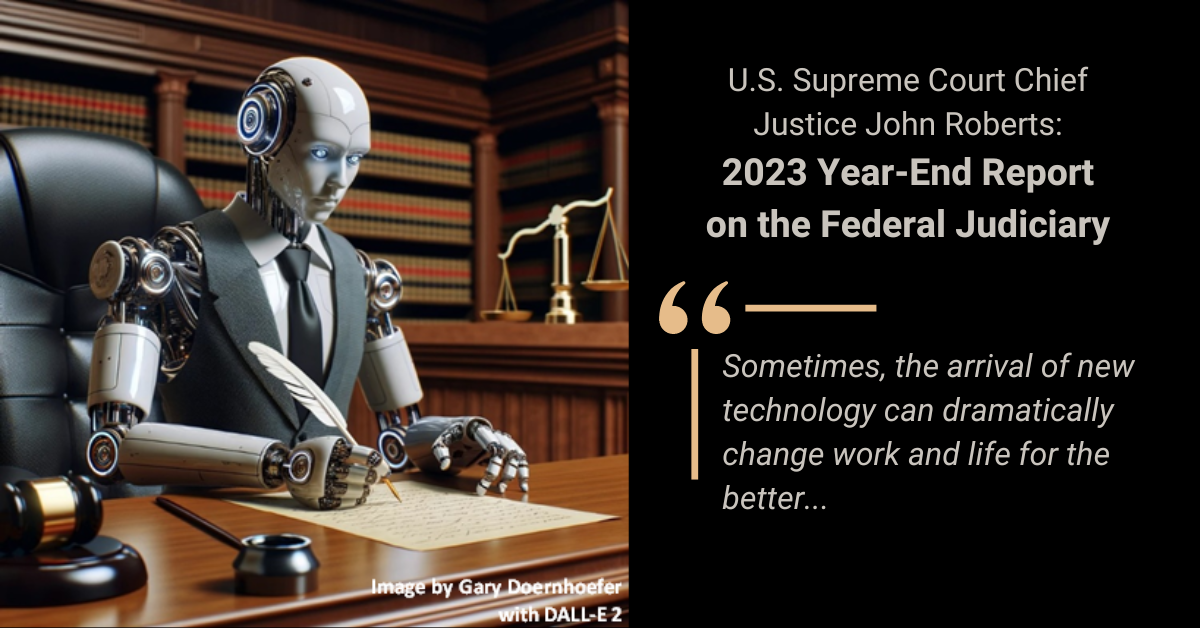Gradual Adoption of Technology has Made the Administration of Justice More Efficient. But What Comes Next?
 United States Supreme Court Chief Justice John Roberts’s 2023 Year-End Report on the Federal Judiciary focuses on the role of technology in the courts. It provides a fascinating history of the gradual adoption of technology by the judiciary. As a starting point, he notes the placement of white goose quill pens at counsel table in the Supreme Court, a practice which continues today, providing a nice memento for counsel appearing before the court and a nod to tradition.
United States Supreme Court Chief Justice John Roberts’s 2023 Year-End Report on the Federal Judiciary focuses on the role of technology in the courts. It provides a fascinating history of the gradual adoption of technology by the judiciary. As a starting point, he notes the placement of white goose quill pens at counsel table in the Supreme Court, a practice which continues today, providing a nice memento for counsel appearing before the court and a nod to tradition.
His report marches through time identifying milestones along the way, such as the use of typewriters, dictaphones, and the provision of personal computers for judges and clerks in 1989. He recounts how developments in electronic discovery and digital filing and records management greatly reduced the amount of paper involved in the judicial process.
Chief Justice Roberts’s report eventually addresses the latest challenge – the use of generative AI. He sums up his perspective saying, “AI obviously has great potential to dramatically increase access to key information for lawyers and non-lawyers alike. But just as obviously it risks invading privacy interests and dehumanizing the law.”
As he concludes, he forecasts a durable need for a human judiciary. He references studies that find people still perceive fellow humans as likely to be more fair than machines, and a belief that humans are better able to detect minute cues during human communication that affect our perceptions of sincerity or prevarication. Even in appellate work, where the facts have been determined, he contrasts the backward-looking limitations of AI, which is based on data inputs, compared with the need to extend or develop the law into novel applications which he asserts requires human judgment and nuance.
While analyzing the role of technology in the courts throughout his report, Chief Justice Roberts recognizes the tremendous gains in efficiency that technology has brought to judges, clerks and staff that collaborate to administer justice. That same principle – that technology can achieve greater efficiency, but must remain cognizant – and at times, humble – in the face of tasks that are uniquely human is shared by the team at ADR Notable. We strive to identify the tasks where technology can clearly benefit the process of dispute resolution by adding efficiency, while remaining sensitive to the essential role of the dispute resolution professional. We even acknowledge the past traditions merging into the present in our company logo, which depicts a fountain pen tip on a computer screen.
You can learn more about how we can help you administer your cases, or even your entire firm, by signing up for a live demo or registering for a free trial. We’ve increased the trial to 21 days to give busy people a little more time to experience the benefits of the many features in the platform. As always, no credit card is required to give it a test drive.






